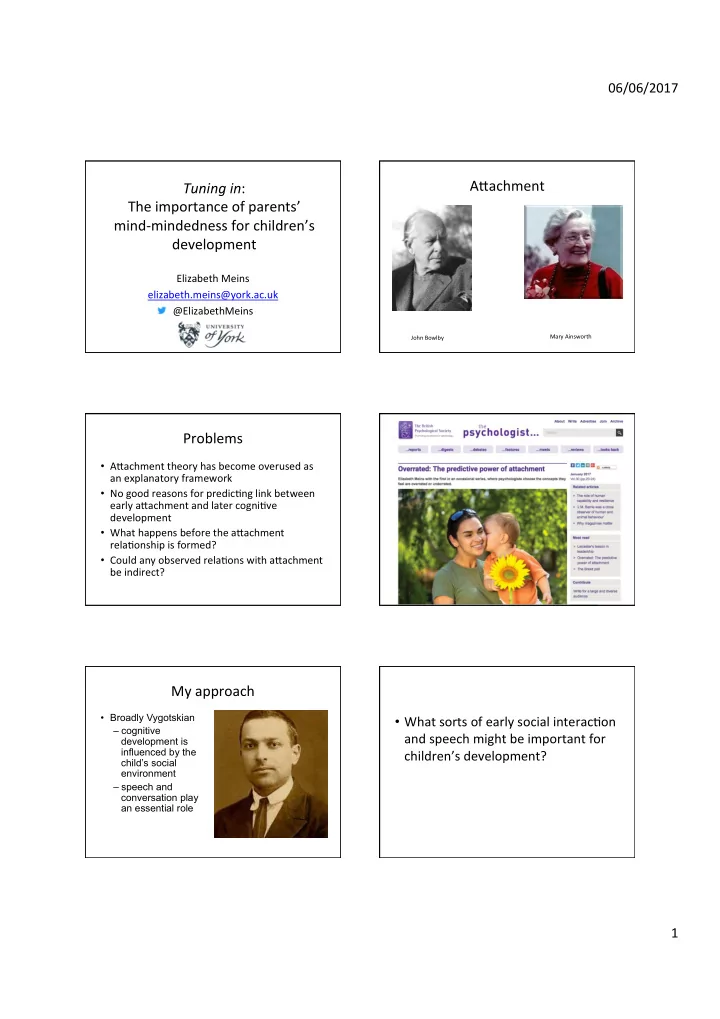

06/06/2017 ¡ AFachment ¡ Tuning ¡in : ¡ The ¡importance ¡of ¡parents’ ¡ ¡ • JJ ¡ mind-‑mindedness ¡for ¡children’s ¡ development ¡ Elizabeth ¡Meins ¡ elizabeth.meins@york.ac.uk ¡ @ElizabethMeins ¡ ¡ Mary ¡Ainsworth ¡ John ¡Bowlby ¡ ¡ Problems ¡ • AFachment ¡theory ¡has ¡become ¡overused ¡as ¡ an ¡explanatory ¡framework ¡ • No ¡good ¡reasons ¡for ¡predicNng ¡link ¡between ¡ early ¡aFachment ¡and ¡later ¡cogniNve ¡ development ¡ • What ¡happens ¡before ¡the ¡aFachment ¡ relaNonship ¡is ¡formed? ¡ • Could ¡any ¡observed ¡relaNons ¡with ¡aFachment ¡ be ¡indirect? ¡ My ¡approach ¡ • Broadly Vygotskian • What ¡sorts ¡of ¡early ¡social ¡interacNon ¡ – cognitive and ¡speech ¡might ¡be ¡important ¡for ¡ development is influenced by the children’s ¡development? ¡ child’s social environment – speech and conversation play an essential role 1 ¡
06/06/2017 ¡ Taking ¡the ¡“intenNonal ¡stance” ¡ He ¡was ¡my ¡third ¡child. ¡He’s ¡about, ¡em, ¡how ¡tall ¡ • Individual ¡differences ¡in ¡mothers’ ¡aFribuNon ¡ would ¡he ¡be? ¡He’s ¡slightly ¡taller ¡than ¡average ¡ of ¡meaning ¡to ¡infants’ ¡early ¡vocalisaNons ¡ for ¡his ¡age. ¡He’s ¡fairly ¡thin, ¡not ¡a ¡lot ¡of ¡beef ¡on ¡ (Meins, ¡1998) ¡ him. ¡He ¡has ¡mousy-‑coloured ¡hair. ¡He ¡has, ¡em, ¡ • Individual ¡differences ¡in ¡mothers’ ¡tendency ¡to ¡ greeny, ¡spongy ¡eyes, ¡nice ¡eyelashes. ¡Fairly ¡long ¡ describe ¡their ¡3-‑year-‑olds ¡with ¡reference ¡to ¡ face. ¡PreFy ¡pale-‑coloured. ¡Em, ¡bit ¡of ¡a ¡giggler. ¡ their ¡mental ¡characterisNcs ¡(Meins ¡et ¡al., ¡ Cut ¡all ¡his ¡teeth. ¡Has ¡a ¡good ¡sense ¡of ¡humour. ¡ 1998) ¡ Bit ¡of ¡a ¡cough. ¡Full ¡of ¡fun, ¡really, ¡I ¡suppose. ¡ ¡ Quite ¡boisterous. ¡ ¡ I ¡think ¡she’s ¡a ¡vivacious, ¡just ¡3-‑year-‑old. ¡She’s ¡ Erm, ¡he’s ¡about ¡3 ¡foot ¡3 ¡high. ¡Blond ¡hair. ¡Er, ¡ got ¡quite ¡a ¡strong ¡personality, ¡but ¡she’s ¡very ¡ dark ¡brown ¡eyes, ¡very ¡long ¡eyelashes. ¡Very ¡ sort ¡of, ¡a ¡loving, ¡caring ¡liFle ¡girl ¡really. ¡And ¡em, ¡ small ¡face, ¡but ¡a ¡big ¡build ¡for ¡his ¡age. ¡Size ¡10 ¡ well, ¡she’s ¡become ¡a ¡real ¡companion ¡now. ¡I ¡ feet. ¡He’s ¡got ¡the ¡front ¡lea ¡tooth ¡black ¡because ¡ don’t ¡know ¡what ¡else ¡to ¡say ¡about ¡her, ¡except ¡ he ¡fell ¡on ¡it ¡as ¡a ¡2-‑year-‑old. ¡He’s ¡got ¡a ¡birthmark ¡ she’s ¡a ¡lovely ¡liFle ¡girl. ¡Quite ¡independent, ¡plays ¡ on ¡his ¡lea ¡hand ¡shoulder. ¡He’s ¡got, ¡erm, ¡the ¡ on ¡her ¡own ¡quite ¡a ¡bit, ¡once ¡she ¡gets ¡herself ¡ birthmark ¡of ¡a ¡haemangioma ¡on ¡the ¡back ¡of ¡his ¡ organised. ¡And ¡her ¡imaginaNon’s ¡just ¡started, ¡ lea ¡leg. ¡Er, ¡he’s ¡a ¡pain ¡in ¡the ¡neck. ¡He’s ¡just ¡ sort ¡of, ¡to ¡take ¡off, ¡and ¡I ¡hear ¡her ¡playing ¡games ¡ started ¡to ¡sleep, ¡3 ¡months ¡ago, ¡through ¡the ¡ with ¡her ¡animals ¡and ¡things, ¡and ¡talking ¡to ¡ night. ¡And ¡I ¡think ¡he’s ¡very ¡bright ¡for ¡his ¡age. ¡ them. ¡She’s ¡great ¡fun ¡to ¡be ¡with. ¡ ¡ ¡ ¡ Taking ¡the ¡“intenNonal ¡stance” ¡ Outline ¡ • Individual ¡differences ¡in ¡mothers’ ¡aFribuNon ¡ • Defining ¡mind-‑mindedness ¡(MM) ¡ of ¡meaning ¡to ¡infants’ ¡early ¡vocalisaNons ¡ • MM ¡and ¡children’s ¡development ¡ (Meins, ¡1998) ¡ • Can ¡you ¡teach ¡people ¡to ¡be ¡more ¡mind-‑ • Individual ¡differences ¡in ¡mothers’ ¡tendency ¡to ¡ describe ¡their ¡3-‑year-‑olds ¡with ¡reference ¡to ¡ minded? ¡ their ¡mental ¡characterisNcs ¡(Meins ¡et ¡al., ¡ 1998) ¡ ¡ è Could ¡differences ¡in ¡caregivers’ ¡aFunement ¡ to ¡the ¡child’s ¡mental ¡world ¡provide ¡a ¡good ¡ explanatory ¡framework ¡for ¡predicNng ¡ development? ¡ 2 ¡
06/06/2017 ¡ Mind-‑mindedness ¡(Meins, ¡1997) ¡ How ¡do ¡you ¡measure ¡MM? ¡ • The ¡caregiver’s ¡tendency ¡to ¡treat ¡the ¡young ¡ • DescripNons ¡of ¡children ¡ child ¡as ¡an ¡individual ¡with ¡a ¡mind ¡of ¡their ¡own ¡ • What ¡about ¡assessing ¡mind-‑mindedness ¡ • Enables ¡caregiver ¡to ¡‘tune ¡in’ ¡to ¡what ¡the ¡child ¡ ‘online’? ¡ may ¡be ¡thinking ¡or ¡feeling ¡ ¡ ¡ ¡ ¡ ¡ ¡ ¡ ¡ ¡ ¡ ¡ ¡ ¡ ¡ ¡ ¡ ¡ ¡ ¡ ¡ ¡ ¡ ¡ ¡ ¡ ¡ ¡ ¡ ¡ ¡ ¡ ¡ • How ¡early ¡in ¡the ¡child’s ¡life ¡do ¡you ¡see ¡mind-‑ mindedness? ¡ InteracNonal ¡MM ¡in ¡the ¡first ¡year ¡of ¡life ¡ Mind-‑related ¡comments ¡ • Can ¡caregivers ¡‘read’ ¡their ¡babies’ ¡minds? ¡ • Appropriate ¡mind-‑related ¡comments ¡– ¡the ¡ caregiver ¡accurately ¡reflects ¡what ¡the ¡infant ¡is ¡ • Do ¡they ¡talk ¡about ¡what ¡their ¡babies ¡might ¡be ¡ thinking ¡or ¡feeling ¡ thinking ¡or ¡feeling, ¡or ¡about ¡their ¡likes, ¡dislikes ¡ and ¡interests? ¡ • Non-‑aFuned ¡mind-‑related ¡comments ¡– ¡the ¡ caregiver ¡misaFributes ¡an ¡internal ¡state ¡to ¡the ¡ • If ¡they ¡do, ¡do ¡they ¡seem ¡to ¡get ¡it ¡right? ¡ child ¡ The ¡MM ¡construct ¡ A ¡mind-‑minded ¡caregiver… ¡ • Scores ¡high ¡on ¡appropriate ¡mind-‑related ¡ • Appropriate ¡and ¡non-‑aFuned ¡comments ¡are ¡ comments ¡ ¡ unrelated ¡(e.g., ¡Meins ¡et ¡al., ¡2003, ¡2012) ¡ • Scores ¡low ¡on ¡non-‑aFuned ¡mind-‑related ¡ • This ¡means ¡that ¡some ¡parents ¡ ¡ comments ¡ ¡– ¡Make ¡high ¡levels ¡of ¡both ¡types ¡of ¡comment ¡ – ¡Make ¡low ¡levels ¡of ¡both ¡types ¡of ¡comment ¡ • Non-‑aFuned ¡are ¡less ¡frequent ¡– ¡over ¡a ¡ ¡– ¡Make ¡high ¡levels ¡of ¡one ¡type ¡of ¡comment ¡and ¡ quarter ¡of ¡parents ¡don’t ¡make ¡them ¡cf. ¡3% ¡ ¡low ¡levels ¡of ¡the ¡other ¡type ¡of ¡comment ¡ who ¡never ¡make ¡an ¡appropriate ¡comment ¡ 3 ¡
Recommend
More recommend